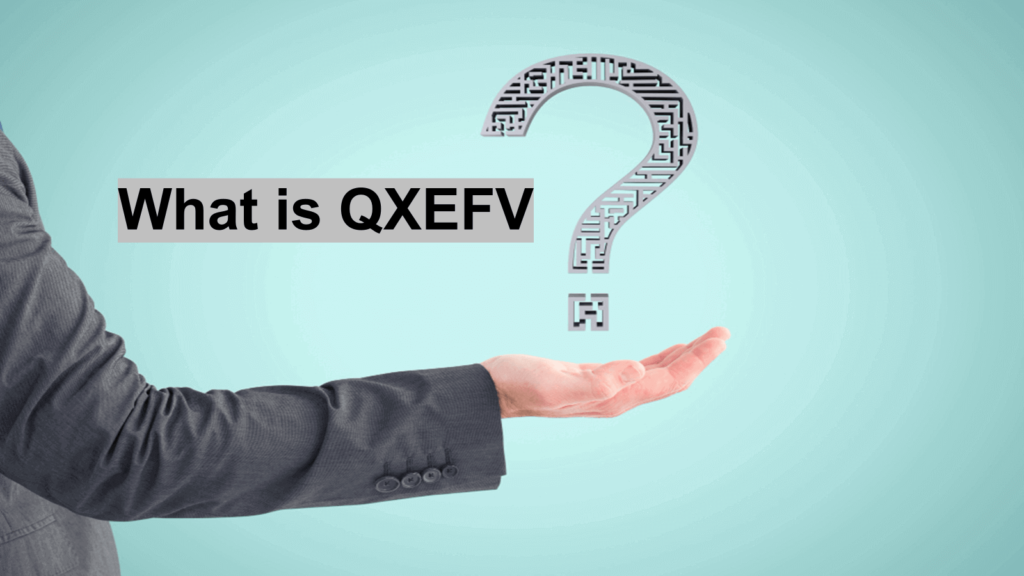“QXEFV is the acronym for “Quantitative Measurement of Experiential Value.” It’s a business methodology that goes beyond traditional metrics like sales figures or simple satisfaction scores.“
Businesses are able to translate the qualitative experiences of customers into quantitative data through QXEFV. This enables them to analyze and understand data and enhance the customer journeys which will enhance loyalty and revenue generation.
In this guide, we’ll be doing a thorough analysis of QXEFV, share its core concepts, delve into its serving mechanism, and probe the treatment of the coming technologies in different sectors.
So whether you’re a professional businessman or a curious newcomer, this article will serve you with everything you need to know about QXEFV to implement this in your business endeavors.
What is QXEFV?
QXEFV stands for “Quantitative Measurement of Experiential Value.” It’s an influential methodology in modern business that aims to quantify the value customers derive from their interactions with products and services.
At its core, QXEFV is about translating qualitative aspects of customer experiences into measurable, quantitative data.
Let’s break it down further:
- Quantitative Measurement: QXEFV uses numerical data and statistical analysis to assign concrete values to customer experiences. This goes beyond traditional metrics like sales figures or simple satisfaction scores.
- Experiential: This involves all interactions a customer has with any brand, product or service. It involves aspects like usability, fun, problem resolution, and gratification.
- Value: In the context of QXEFV, value represents the worth or importance of these experiences to both the customer and the business. This can manifest as increased productivity, financial gains, time efficiency, or emotional satisfaction for the customer.
Foundational Elements of QXEFV?
QXEFV is built on two foundational elements:
- Customer Experience (CX): This covers the each reasoning which lies inside a customer and a particular product or service. Some of the factors that EIVQ comprises are user friendliness, levels of satisfaction and the ways through which the service or the product has helped them.
- Quantitative Value (QV): This refers to the tangible benefits customers receive. QXEFV quantifies advantages such as increased productivity, monetary savings, or time efficiency that result from using a product or service.
Work with QXEFV to step up the level of CX by, in this specific case, measuring and analysing, among other parameters, how customers are served and the results thereafter.
Here we see this new modern approach emerge. Not only is it possible to raise the sales number, but also to develop and maintain better relations with the customers through the constant growth of the value provided
QXEFV in Context
To appreciate the significance of QXEFV, it’s helpful to understand its evolution:
In the mid-20th century, businesses primarily focused on product quality and features. And then, the late 20th century saw the rise of customer satisfaction surveys, followed by metrics like the Net Promoter Score (NPS) in the early 2000s.
QXEFV represents the next step in this evolution, offering a more holistic and nuanced approach to measuring customer experiences. Unlike its predecessors, QXEFV doesn’t rely on a single metric or survey question. Instead, it joins more than one data point to cohesively depict how a customer system behaves.
This diverse method permits companies to pinpoint where the improvements are needed as well as measure how these improvements are effective over a certain period of time.
How QXEFV Works?
Understanding how QXEFV works is key to harnessing its power. At its core, QXEFV is a cyclical process of collecting data, analyzing it, and applying the insights.
Let’s dive into each stage and see how they come together to create a powerful tool for improving customer experiences.
1. Data Collection: The Foundation of QXEFV
QXEFV starts with gathering data from various sources. Imagine you’re running a coffee shop. You might use:
- Surveys and Interviews: Ask customers about their visit. “How was your coffee?” “Was the service friendly?” These direct questions give you clear feedback.
- Analytics Tools: Your website and app can tell you a lot. Which menu items do people click on most? How long do they spend looking at your loyalty program page?
- Direct Observation: Sometimes, just watching is powerful. How do customers react when they first taste their coffee? Do they struggle to find a place to sit?
For Example, Starbucks uses a mix of these methods. They have a feedback section in their app, analyze how customers use their rewards program, and train staff to observe and report on customer behavior in stores.
2. Turning Data into Insights: The Analysis Stage
Once you have this treasure trove of data, it’s time to make sense of it. QXEFV uses several statistical techniques:
- Regression Analysis: This helps you understand relationships. Does faster service lead to higher satisfaction? You might find that cutting wait times by just one minute boosts satisfaction scores significantly.
- Factor Analysis: This uncovers hidden patterns. You might discover that customers who love your lattes also tend to buy pastries and work on laptops in your shop.
- Conjoint Analysis: This shows what customers value most. Is it more important to have comfy chairs or fast Wi-Fi? This analysis can tell you.
Netflix is a master at this. They use complex algorithms to analyze viewing habits, helping them decide everything from what shows to produce to how to design their user interface.
3. Putting Insights into Action: The Application Stage
Now comes the exciting part – using what you’ve learned to improve your business:
- Product Development: Your analysis might show that customers love flavored syrups but find your current options limited. Time to expand your flavor range!
- Service Enhancement: If data shows that customers value quick service above all else, you might invest in training baristas to work more efficiently or even add self-service stalls.
- Marketing and Communication: Did you discover that your eco-friendly practices are a hit with customers? Make sure your marketing highlights your green initiatives.
Amazon is a great example of applying QXEFV insights. They continuously refine their recommendation engine based on customer behavior, making the shopping experience more personalized and efficient.
Benefits of Implementing QXEFV
As customer experience has become the most transformaational competitive advantage today’s organizations face, QXEFV offers businesses a systematic way of examining, tracking, and enhancing customers’ experience.
This approach enables the companies to perform analysis as opposed to relying on instinct and story-telling.
Now, let’s look at the primary benefits that help in the relative of QXEFV in all business sectors:
1. Enhanced Decision Making:
QXEFV provides data-driven insights that enable more informed decision-making across all levels of an organization.
For instance, a business can identify pain points in the customer journey with precision, allocate resources more effectively to areas that truly impact customer satisfaction, and make strategic choices based on concrete evidence rather than assumptions.
2. Gained Customer Loyalty:
with the help of experiential value again QXEFV helps businesses create closer and more durable bonds with customers, thus leading to a higher level of customer retention, a higher chances of generating positive references, and the increase in the value of each customer over his lifespan
A research report by Bain & Company states that the effects of an improved retention particularly customer retention improved by just five percent can lead to an improvement of profits between twenty-five percent to ninety-five percent.
3. Competitive Advantage:
In today’s crowded marketplace, QXEFV can be a key differentiator. Businesses that effectively implement QXEFV offer more tailored and satisfying customer experiences, and they respond more quickly to changing customer needs and preferences. Plus, they build a reputation for customer-centricity as well.
This advantage is particularly crucial in industries where product offerings are similar, and customer experience becomes the primary differentiator.
4. Innovation Driver:
QXEFV doesn’t just measure current experiences; it also paves the way for future innovations, like it identifies unmet customer needs, provides insights, and encourages a culture of continuous improvement and innovation within the organization.
For example, Netflix’s use of viewing data (a form of QXEFV) not only improves its recommendation algorithm but also informs decisions about which original content to produce.
QXEFV Across Industries
Different industries are leveraging QXEFV to enhance customer experiences and drive business growth.Consider the following instances.
1. Retail and E-Commerce:
QXEFV is utilized by retailers to enhance personalisation, maximise stock levels and improve store design. For instance, Amazon’s recommendation engine, based on QXEFV principles, drives 35% of its total sales through personalized suggestions.
2. Healthcare:
In healthcare, QXEFV helps measure patient satisfaction, optimize treatments, and improve telemedicine experiences. Take Cleveland Clinic, for instance. Their patient satisfaction score rose to a significant level after implementing QXEFV-driven improvements.
3. Financial Services:
Banks and investment firms use QXEFV to tailor financial advice, enhance fraud detection, and improve digital banking experiences. This approach helps banks offer better services, tighter security, and smoother digital banking, making customers happier and more trusting of online finance.
4. Technology and Software:
Tech companies leverage QXEFV for UX optimization, feature prioritization, and customer support enhancement. Many software firms report significant increases in user engagement and satisfaction after implementing QXEFV-driven improvements to their interfaces and features.
Challenges in QXEFV Implementation
While QXEFV offers numerous benefits, its implementation comes with several challenges:
1. Data Privacy Concerns:
As QXEFV relies heavily on customer data, organizations must navigate complex privacy regulations like GDPR and CCPA. Dataprotection while accumulating complete information requires certain security and use of data in an open manner. It has never been easy for organizations to achieve a healthy compromise between personalization and privacy, secure explicit consent, and anonymize data when necessary.
2. Complexity of Integration:
Implementing QXEFV often requires integrating multiple data sources and systems, which can be technically challenging and resource-intensive. Legacy systems may not be compatible with new QXEFV tools, necessitating significant upgrades or replacements. Additionally, ensuring data consistency across various touchpoints can be a complex task.
3. Balancing Quantitative and Qualitative Insights:
While QXEFV aims to quantify experiences, it’s crucial not to lose sight of qualitative insights. Over-reliance on numbers can lead to overlooking valuable context and nuances in customer feedback. Organizations must develop frameworks that effectively combine quantitative metrics with qualitative understanding to gain a holistic view of customer experiences.
How to Get Started with QXEFV?
Implementing QXEFV in your organization is a transformative process that requires careful planning and execution. This section will guide you through the essential steps to successfully integrate QXEFV into your business operations.
Step #1: Assessing Your Current CX Measurement
It is important to first consider your current structures of customer experience metrics practices before you delve into QXEFV.
- Audit existing metrics: Examine any and all current metrics aligned with customer experience, Comprehensive or Efficiency metrics, Surveys asking customers about their experiences (e.g. NPS, CSAT, CES, etc.,).
Identify gaps: Identify and evaluate what is currently measured and where, if any, coverage can be improved in terms of the broader customer experience measurements. - Map the customer journey: Create a comprehensive map of the customer journey outlining all the points of contact so that there are no blind spots when it comes to implementing the QXEFV.
- Assess data collection methods: Conduct an analysis of present data collection approaches, with the aim of addressing how well they fulfil their purpose.
- Stakeholder input: Collect data from different departments (sales and marketing, customer service) about the problems they face with the measurement of customer experience and what metrics they would use.
Step #2: Choosing the Right Tools and Metrics
Selecting appropriate tools and metrics is crucial for effective QXEFV implementation:
- QXEFV-specific software: Invest in specialized software that can integrate various data sources and perform complex analyses. Some potential choices comprise Qualtrics XM, Medallia, and InMoment.
- Data integration platforms: Implement tools that can consolidate data from multiple sources (e.g., CRM systems, social media, website analytics) for a holistic view of customer experiences.
- Key Performance Indicators (KPIs): Create a small set of KPIs, which will be specific for QXEFV and which will correlate with the objectives of your business. These can be:
- Experience-Driven Revenue (EDR): Assess the income which is associated with better experience particularly delivered to customers.
- Customer Lifetime Value (CLV): Estimate how much a single customer would generate for the business in total during the whole of ongoing relationship.
- Experience Quality Score (EQS): Overall score that measures experience across contact points.
- Sentiment analysis tools: Leverage means which allow a more accurate understanding of the customers’ emotional state based on feedback and interactions using analytical sentiment tools.
- Real-time feedback mechanisms: Implement tools for collecting immediate feedback at crucial touchpoints (e.g., post-purchase surveys, chatbots).
Step #3: Building a QXEFV-Centric Culture
Creating a culture that embraces QXEFV is essential for its long-term success. Here are some steps you can take for that:
- Leadership buy-in: Secure commitment from top management to champion QXEFV across the organization.
- Employee training: Conduct comprehensive training sessions to educate all employees about QXEFV principles and their role in enhancing customer experiences.
- Cross-functional collaboration: Foster cooperation between departments to ensure a unified approach to QXEFV implementation.
- Incentive alignment: Adjust employee performance metrics and incentives to reflect QXEFV goals, encouraging behavior that enhances customer experiences.
- Regular communication: Establish channels for sharing QXEFV insights and success stories throughout the organization.
- Continuous improvement: Implement a feedback loop where QXEFV insights drive ongoing enhancements to products, services, and processes.
- Customer-centric decision-making: Encourage the use of QXEFV data in all major business decisions, from product development to marketing strategies.
- Experimentation culture: Promote a mindset of continuous experimentation and learning based on QXEFV insights.
Conclusion:
QXEFV is revolutionizing how businesses understand and respond to customer needs. In line with its progress, QXEFV is anticipated to further ultrafine, constructing meaningful and engaging real-time experiences that know exactly what the customer wants even before uttering a word.
This evolution of the system will not be completed without integrating how QXEFV will meet the prospects of AI and machine learning within a rich dataset provided through IOT where feedback, predictions to any interaction with customers will be received and acted upon.
The emergence of these technologies from predictive analytics to emotion AI is a game changer in the way businesses will be run by creating a paradigm shift from products to experiences. Soon, QXEFV will become a cornerstone of business strategy, driving decisions at all levels. Companies that master QXEFV will lead in the experience economy, forging stronger connections with customers and setting new standards for personalization and service.
However, at the end of the day, remember, QXEFV isn’t a one-time thing. It’s an ongoing cycle. You collect data, analyze it, make changes, and then start over, constantly refining and improving.
FAQs: What is QXEFV
QXEFV goes beyond simple satisfaction scores. While traditional metrics might ask, "Are you satisfied?” QXEFV digs deeper. It looks at the entire customer journey, measuring not just satisfaction but also the value customers get from their experiences. It turns qualitative experiences into quantitative data, giving businesses a more complete picture of customer interactions.
Yes, QXEFV can be scaled to fit businesses of all sizes. It is especially useful addressing small businesses in a way that improves customer understanding, decision-making and competition against other larger firms. The strategy is to begin at the bottom, identify important contact points and increase the application of QXEFV as the organization develops.
There is no absolute answer to this question but conducting assessments regularly is important. Periodic assessments are helpful for many companies, which is why they tend to be done on a quarterly basis so that changes can be noticeable and trends can be followed over time. On the other hand, some of these QXEFV aspects, such as real time feedback, can be constant. The most important is, definitely, to find a rhythm that is appropriate for your company, and adhere to it. This way, you are always on track regarding your customers’ experiences..
QXEFV can help B2B companies understand the complexities of their often longer and more involved customer journeys. It can measure things like the effectiveness of account management, the value of support services, and the impact of product training. Using QXEFV, B2B businesses can strengthen their client relationships and differentiate themselves in competitive markets.



